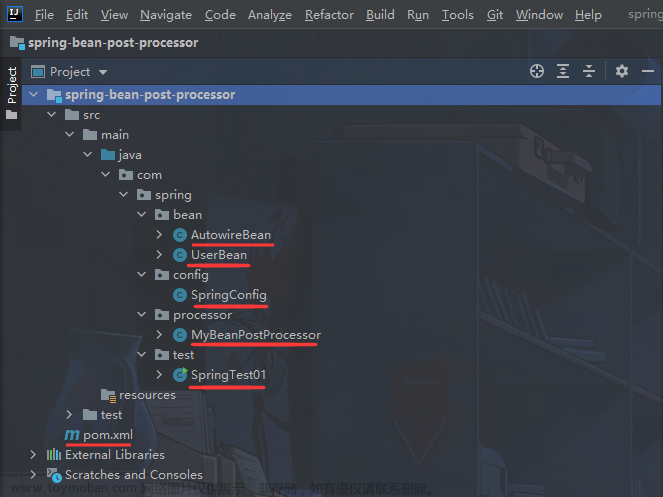Spring框架的强大之处在于其提供了丰富的扩展点,其中之一是BeanPostProcessor接口。这个接口允许我们在Spring容器实例化bean之后、在调用初始化方法之前和之后对bean进行一些自定义的处理。在这篇文章中,我们将深入研究BeanPostProcessor的使用场景,并通过一个详细的例子演示如何应用它来实现一些强大的功能。
背景
在讨论具体应用之前,让我们先了解一下BeanPostProcessor的基本作用。它允许我们在Spring容器初始化bean的过程中,对每个bean实例进行额外的处理。我们可以在bean的初始化前后执行自定义逻辑,从而实现各种高级功能。
示例:检查实现特定接口的Bean
假设我们有一个接口MyInterface,并有两个实现类MyInterfaceImpl1和MyInterfaceImpl2:
public interface MyInterface {
void myMethod();
}
@Component
public class MyInterfaceImpl1 implements MyInterface {
@Override
public void myMethod() {
System.out.println("MyInterfaceImpl1's method called.");
}
}
@Component
public class MyInterfaceImpl2 implements MyInterface {
@Override
public void myMethod() {
System.out.println("MyInterfaceImpl2's method called.");
}
}
我们想要在所有bean初始化后,检查并输出哪些bean实现了MyInterface接口。这时就可以使用BeanPostProcessor来实现这个功能。
import org.springframework.beans.BeansException;
import org.springframework.beans.factory.config.BeanPostProcessor;
import org.springframework.stereotype.Component;
@Component
public class InterfaceCheckerBeanPostProcessor implements BeanPostProcessor {
@Override
public Object postProcessBeforeInitialization(Object bean, String beanName) throws BeansException {
// 在初始化前执行的逻辑
System.out.println("Before Initialization - Bean Name: " + beanName);
return bean;
}
@Override
public Object postProcessAfterInitialization(Object bean, String beanName) throws BeansException {
// 在初始化后执行的逻辑
System.out.println("After Initialization - Bean Name: " + beanName);
// 检查bean是否实现了特定接口
if (bean instanceof MyInterface) {
System.out.println(beanName + " implements MyInterface!");
}
return bean;
}
}
在这个例子中,InterfaceCheckerBeanPostProcessor实现了BeanPostProcessor接口,重写了postProcessBeforeInitialization和postProcessAfterInitialization方法。在初始化后,它会检查每个bean是否实现了MyInterface接口,如果是,则输出相关信息。
应用场景
1. 自定义初始化逻辑
通过实现BeanPostProcessor接口,我们可以在bean初始化前或初始化后执行自定义的逻辑,例如记录日志、执行一些操作等。
2. 属性赋值的定
在postProcessBeforeInitialization方法中,我们可以获取bean的属性,并在初始化前对属性进行定制或检查,实现更灵活的属性赋值。
3. AOP(面向切面编程)
BeanPostProcessor可用于实现自定义的AOP操作。在postProcessBeforeInitialization方法中,我们可以动态生成代理对象,以实现方法拦截和增强。
4. Bean验证
通过BeanPostProcessor可以在初始化前或初始化后执行一些验证操作,确保bean的状态是符合要求的。
5. 自定义注解处理
如果我们定义了自己的注解,并希望在bean初始化前或初始化后执行一些逻辑,BeanPostProcessor提供了一个理想的扩展点。文章来源:https://www.toymoban.com/news/detail-824507.html
结语
通过这个例子,我们深入了解了BeanPostProcessor的应用场景和实际使用方法。它为我们提供了在Spring容器中定制bean的强大工具,可以根据实际需求执行各种操作。然而,使用时需要谨慎,确保逻辑清晰,不要过度依赖它,以免引入不必要的复杂性。在实际项目中,合理选择扩展点,能够更好地发挥Spring框架的强大功能。希望这篇文章对你理解和应用BeanPostProcessor提供了帮助。文章来源地址https://www.toymoban.com/news/detail-824507.html
到了这里,关于深入了解 Spring BeanPostProcessor 的应用的文章就介绍完了。如果您还想了解更多内容,请在右上角搜索TOY模板网以前的文章或继续浏览下面的相关文章,希望大家以后多多支持TOY模板网!











